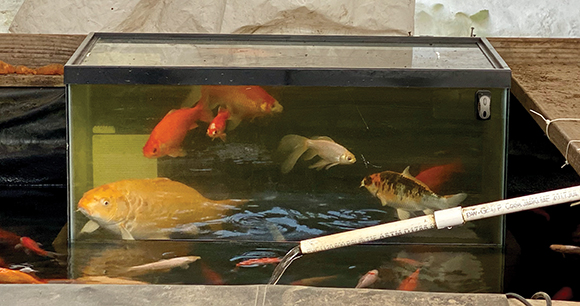by Sasha Prasad-Shreckengast, MA student, CUNY Hunter College
Curiosity—the drive to gather information—is considered a fundamental motivation throughout the animal kingdom. As such, providing opportunities to satisfy that curiosity may be essential for animals to have good welfare in captivity. Fish are held in captivity at some of the highest numbers of any taxa, but their curiosity is rarely studied or accommodated. It is estimated that upwards of 1 million individuals of the Cyprinidae family, which includes carp and true minnows, are used annually in research on human development and physiology. Yet, housing plans for laboratory fishes have been modeled from the aquaculture industry, prioritizing production and functionality over welfare, resulting in barren tanks and minimal cognitive stimulation for the animals residing in them.

With this study, which was funded by an AWI Refinement Grant, we investigated the presence and nature of curiosity in goldfish (Carassius auratus) via novel free-choice exploration opportunities. To achieve this, we created a “fish tower”—a filled and inverted glass aquarium that extended above the surface of the water at a community aquaponics pond that housed approximately 100 goldfish. The fish tower thus represents an unusual and potentially risky novel environment, but if utilized by the fish, could be useful in future curiosity research and could promote cognitive stimulation and agency for fish in captivity.
We filmed the fish tower for five weeks, beginning immediately after installation, and coded total occupancy every hour for 5-10 hours per day, 3-4 days per week. For 18 easily identifiable individuals, we also recorded the time it took them to first enter the tower (latency) and the total number of entries. Despite its physical characteristics—transparent, well lit, above the surface—that go against their known preferences, goldfish voluntarily explored the novel fish tower. Fish were seen in the tower in 70 percent of all scans; of those scans, two was the most common number observed in the tower, and seven the maximum. Furthermore, there was variation in latency to enter the fish tower and total number of entries for the 18 identifiable individuals who explored the fish tower, which suggests individual differences in interest and information gathering.
Overall, these results indicate that the fish tower may be a suitable method for providing free-choice exploration opportunities and visual stimulation for fish in captivity. Additionally, it could be a useful tool for further studies of curiosity and its effects on fish welfare. By showing that fish will readily explore an unusual and risky novel environment, the present work contributes to the ongoing research examining the interests and abilities of fish. While additional research is needed to determine the welfare benefits that exploration opportunities offer for goldfish, the fish tower presents an option for enrichment that is often lacking in captive environments and can be implemented in a variety of settings, including those research laboratories with more stringent restrictions on what can be added to the aquatic environments.